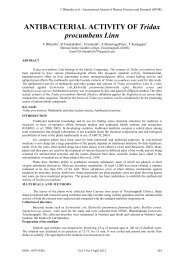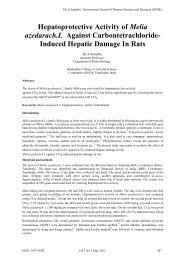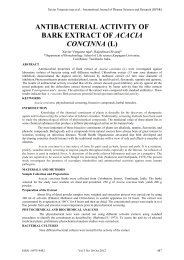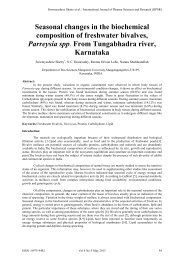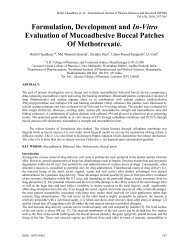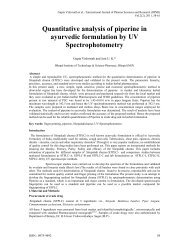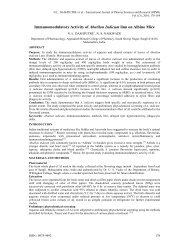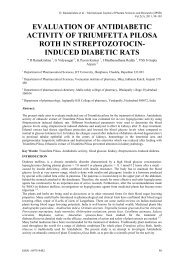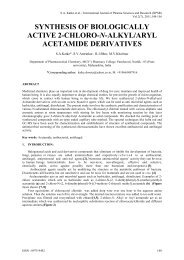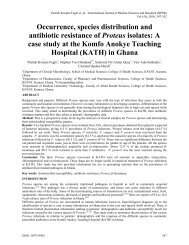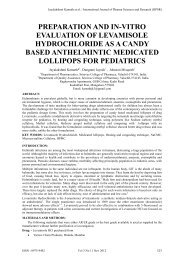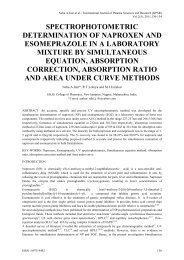ANTIMICROBIAL ACTIVITY OF LEAF EXTRACTS OF Sida acuta Burm.
ANTIMICROBIAL ACTIVITY OF LEAF EXTRACTS OF Sida acuta Burm.
ANTIMICROBIAL ACTIVITY OF LEAF EXTRACTS OF Sida acuta Burm.
Create successful ePaper yourself
Turn your PDF publications into a flip-book with our unique Google optimized e-Paper software.
Akilandeswari .S et. al. / International Journal of Pharma Sciences and Research (IJPSR)<br />
Vol.1(5), 2010, 248-250<br />
<strong>ANTIMICROBIAL</strong> <strong>ACTIVITY</strong> <strong>OF</strong> <strong>LEAF</strong><br />
<strong>EXTRACTS</strong> <strong>OF</strong><br />
<strong>Sida</strong> <strong>acuta</strong> <strong>Burm</strong>.<br />
Akilandeswari .S, R.Senthamarai, Prema.S and R.Valarmathi<br />
Department of Pharmacognosy and Pharmaceutical chemistry<br />
Periyar College of Pharmaceutical Sciences for girls,<br />
Tiruchirappalli - 620 021.<br />
Abstract<br />
Phytochemical investigations, Antibacerial and antifungal activity studies for leaf extracts of <strong>Sida</strong> <strong>acuta</strong> were<br />
carried out. Two common solvents i.e Chloroform and Ethanol (95%) were used successively for extraction of<br />
active principles from the dried powdered leaves. The Phytochemical tests of extracts revealed the Presence of<br />
Carbohydrates, Alkaloids, Phytosterols, Saponins and fixed Oils.The antimicrobial screening was done with two<br />
Gram +ve (Staphylococcus aureus NCIM 2079, Bacillus subtilis NCIM 2063) and two Gram –ve (E.coli NCIM<br />
2065 Pseudomonas aeruginosa NCIM 2036) bacteria and fungi (Candida albicans NCIM 3102, Aspergillus niger<br />
NCIM 1054) as test microorganisms. All the three microorganisms were markedly effected by both the extracts<br />
under study.<br />
Keywords: Phytoconstituents, Leaf extracts, Antibacterial and Antifungal activity, <strong>Sida</strong> <strong>acuta</strong><br />
Introduction<br />
<strong>Sida</strong> <strong>acuta</strong> (Malvaceae), is an erect perennial shrub found throughout the hotter parts of India and Nepal. It is<br />
used for various medicinal purposes such as liver disorders, diuretic & abortifacient, in Ayurvedic preparations,<br />
asthma, fever, headache (migraine), cough, cold, ulcer, anthelmintic, snake bite, urinary diseases, female disorders,<br />
antifertility agents and sedative 1,2 . The present study is undertaken to evaluate the antimicrobial potential of the<br />
extract of <strong>Sida</strong> acutL<br />
Experimental<br />
Preparation of extract<br />
The leaves of <strong>Sida</strong> <strong>acuta</strong> were collected at Tiruchirappalli, Tamilnadu, India. The leaves were shade dried,<br />
pulverized and sieved through 40 mesh. The powdered leaves were successively extracted with Chloroform,<br />
Ethanol in soxhlet apparatus.. The extracts obtained were evaporated under vacuum to remove the solvent<br />
completely. Then these were taken for further study.<br />
Organisms used<br />
Bacterial strains used for testing included Bacillus subtilis Staphylococcus aureus, Escherichia coli, and<br />
Pseudomonas aeruginosa. The fungi used was Candida albicans and Aspergillus niger. These were obtained from<br />
National collection of Industrial Microorganisms, Pune, India. The stock culture was maintained on Mueller Hinton<br />
agar medium (Himedia chemicals) at 37 o C.<br />
Antimicrobial activity<br />
Antibacterial activity of the extract of <strong>Sida</strong> <strong>acuta</strong> was studied using the disc diffusion method 3,4 . Petri plates<br />
containing 10 ml of Muller Hinton agar medium were seeded with 24h old culture of a selected bacterial strain.<br />
Sterile filter paper discs (6 mm) containing 100mg/disc of a plant extract residue dissolved in acetone were placed<br />
on the surface of the medium. Acetone and water alone served as negative controls. A standard disc containing<br />
reference antibiotics (Gentamycin 10 mcg//Nystatin 100 units) were used as a positive control. Incubation was done<br />
for 24h at 37 0 C. The assessment of anitbacteial activity was based on the measurement of diameter of zone of<br />
inhibition formed around the disc. Six determinations were conducted for the extract. The same was done for C.<br />
albicans except the medium used was potato agar.<br />
ISSN : 0975-9492 248
Akilandeswari .S et. al. / International Journal of Pharma Sciences and Research (IJPSR)<br />
Vol.1(5), 2010, 248-250<br />
Results and discussion<br />
The results of preliminary Phytochemical screening and antimicrobial activity of <strong>Sida</strong> <strong>acuta</strong> leaves extract are<br />
given in Tables 1 & 2 respectively<br />
The Phytochemical tests of crude extracts revealed the presence of Carbohydrates, Alkaloids , Saponins , Fixed<br />
oil and Phytosterols 5,6 . (Table.1) While assessing the anti bacterial activity for both the chloroform and ethanolic<br />
extract, appreciable antibacterial activity was found against all the selected bacteria with the maximum activity<br />
recorded against gram positive Staphylococcus aureus and gram negative Escherichia coli respectively.<br />
These effects were compared with the commercially available antibiotics under the same laboratory<br />
conditions and activity index was calculated ( Table 2).The results further showed that the extracts were having<br />
more potent antibacterial activity and antifungal activity.<br />
These results suggest the presence of potent antibacterial and antifungal activity of the extracts against the<br />
bacteria and fungi might be due to naturally occurring bioactive Phytochemicals present in the plant drug. It could<br />
be concluded that detailed characterization of various compounds from leaves of <strong>Sida</strong> <strong>acuta</strong> is needed, so that<br />
structure activity relationship in term of antibacterial activity and antifungal activity could be investigated. The high<br />
degree of antibacterial activity and antifungal activity seems to confirm the folk therapy of infections and traditional<br />
therapeutic claims of this herb. Table: 1<br />
Preliminary Phytochemical Screening of Leaf Extracts of <strong>Sida</strong> <strong>acuta</strong>. L<br />
S.No Phytoconstituents Chemical tests Chloroform<br />
extract<br />
Ethanolic extract<br />
1 Carbohydrates Molisch test + +<br />
2 Alkaloids Dragnodraffs,<br />
Mayers and Hagers<br />
test<br />
3 Phytosterols Liberman&<br />
Burchard test<br />
+ +<br />
_ +<br />
4 Saponins Foarm test + +<br />
5 Fixed oils Stain test + +<br />
ISSN : 0975-9492 249
Akilandeswari .S et. al. / International Journal of Pharma Sciences and Research (IJPSR)<br />
Vol.1(5), 2010, 248-250<br />
Table:2<br />
Antimicrobial activity of Leaf Extracts of <strong>Sida</strong> <strong>acuta</strong>. L<br />
Test Microorganisms<br />
I Z* mm/<br />
A I<br />
Chloroform<br />
extract<br />
Ethanolic<br />
extract<br />
Standard drug<br />
Gram positive<br />
Bacillus subtilis<br />
NCIM 2063<br />
I Z<br />
A I<br />
17<br />
0.50<br />
18<br />
0.53<br />
34<br />
Stephylococcus aureus<br />
NCIM 2079<br />
I Z<br />
A I<br />
38<br />
0.90<br />
40<br />
0.95<br />
42<br />
Gram negative<br />
Eschorichia coli<br />
NCIM 2065<br />
I Z<br />
A I<br />
42<br />
0. 98<br />
37<br />
0.86<br />
43<br />
Pseudomonas aeruginosa<br />
NCIM 2036<br />
Fungi<br />
Candida albicans<br />
NCIM 3102<br />
Aspergillus niger<br />
NCIM 1054<br />
I Z<br />
A I<br />
I Z<br />
A I<br />
I Z<br />
A I<br />
21<br />
0.58<br />
24<br />
0.92<br />
11<br />
0.50<br />
20<br />
0.54<br />
23<br />
0.88<br />
15<br />
0.68<br />
37<br />
26<br />
22<br />
I Z = Inhibition Zone (in mm)<br />
A I = Activity index<br />
* Average of three observations adjusted to the nearest whole number.<br />
Activity Idex =<br />
Inhibition Zone of the test sample<br />
Inhibition Zone of the standard<br />
Standard Drugs Gentamycin – 10 mcg<br />
Nystatin – 100 units<br />
References<br />
[1] Anonymous, “The Wealth of India”, Vol 10, Publication and Information Directorate, CSIR, New Delhi, 281, (1985).<br />
[2] Kirtikar, K.R. and Basu, B.D., In; Blatter, E., Caius, J.F. and Mhaskar, K.S., Eds; “Indian Medicinal Plants”, 2nd Edn, Vol II, Lalit<br />
Mohan Basu, Allahabad, India, 1182, (1993).<br />
[3] Naovi, S.A.H., Khan, M.S.Y. and Vohora, S.B., Antibacterial, Antifungal and Anthelmintic investigations on Indian medicinal plants,<br />
Fitoterapia, 62 (3), 221, (1991).<br />
[4] Bauer, A. W., Kirby, M.D.K., Sherris, J.C. and Turck, M., Antibiotic susceptibility testing by standard single disc diffusion method, Am. J.<br />
Cl. Pathol., 45, 493, (1966).<br />
[5] Gary, S.C. and Kasera, H.I., Study of in vitro antibacterial activity of the essential oil of Sphaeranthus indicus L., J. Ethnopharmacol.,<br />
54, 37, (1983).<br />
[6] Irobi, O.N., Moo-youg, M., Anderson, W.A. and Daramola, S.O., Antibacterial activity of bark extracts of Bridelia ferruginea, J.<br />
Ethnopharmacol. 43, 223, (1994).<br />
ISSN : 0975-9492 250



